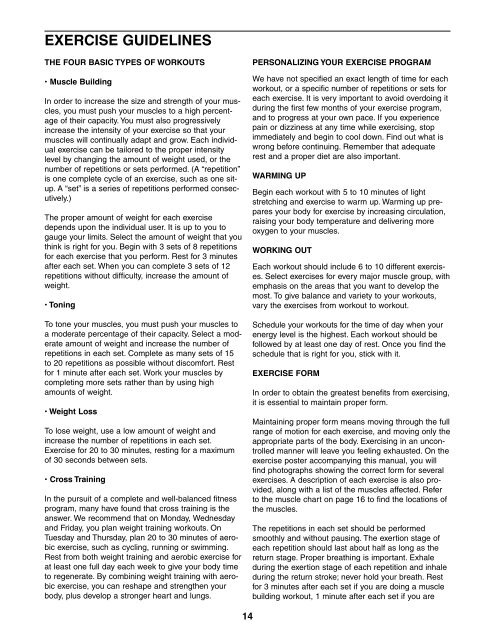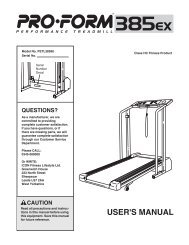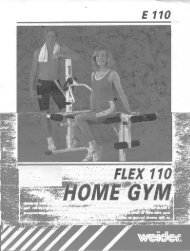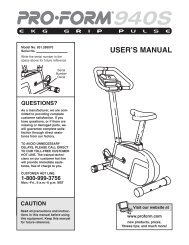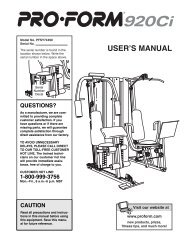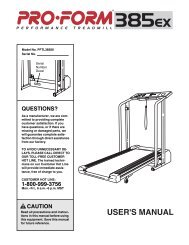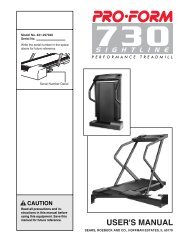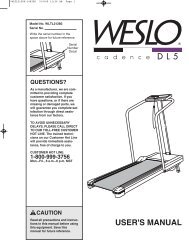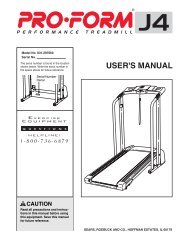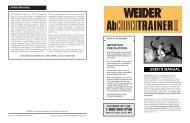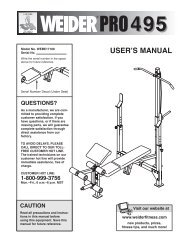You also want an ePaper? Increase the reach of your titles
YUMPU automatically turns print PDFs into web optimized ePapers that Google loves.
EXERCISE GUIDELINES<br />
THE FOUR BASIC TYPES OF WORKOUTS<br />
• Muscle Building<br />
In order to increase the size and strength of your muscles,<br />
you must push your muscles to a high percentage<br />
of their capacity. You must also <strong>pro</strong>gressively<br />
increase the intensity of your exercise so that your<br />
muscles will continually adapt and grow. Each individual<br />
exercise can be tailored to the <strong>pro</strong>per intensity<br />
level by changing the amount of weight used, or the<br />
number of repetitions or sets performed. (A “repetition”<br />
is one complete cycle of an exercise, such as one situp.<br />
A “set” is a series of repetitions performed consecutively.)<br />
The <strong>pro</strong>per amount of weight for each exercise<br />
depends upon the individual user. It is up to you to<br />
gauge your limits. Select the amount of weight that you<br />
think is right for you. Begin with 3 sets of 8 repetitions<br />
for each exercise that you perform. Rest for 3 minutes<br />
after each set. When you can complete 3 sets of 12<br />
repetitions without difficulty, increase the amount of<br />
weight.<br />
• Toning<br />
To tone your muscles, you must push your muscles to<br />
a moderate percentage of their capacity. Select a moderate<br />
amount of weight and increase the number of<br />
repetitions in each set. Complete as many sets of 15<br />
to 20 repetitions as possible without discomfort. Rest<br />
for 1 minute after each set. Work your muscles by<br />
completing more sets rather than by using high<br />
amounts of weight.<br />
• Weight Loss<br />
To lose weight, use a low amount of weight and<br />
increase the number of repetitions in each set.<br />
Exercise for 20 to 30 minutes, resting for a maximum<br />
of 30 seconds between sets.<br />
• Cross Training<br />
In the pursuit of a complete and well-balanced fitness<br />
<strong>pro</strong>gram, many have found that cross training is the<br />
answer. We recommend that on Monday, Wednesday<br />
and Friday, you plan weight training workouts. On<br />
Tuesday and Thursday, plan 20 to 30 minutes of aerobic<br />
exercise, such as cycling, running or swimming.<br />
Rest from both weight training and aerobic exercise for<br />
at least one full day each week to give your body time<br />
to regenerate. By combining weight training with aerobic<br />
exercise, you can reshape and strengthen your<br />
body, plus develop a stronger heart and lungs.<br />
14<br />
PERSONALIZING YOUR EXERCISE PROGRAM<br />
We have not specified an exact length of time for each<br />
workout, or a specific number of repetitions or sets for<br />
each exercise. It is very important to avoid overdoing it<br />
during the first few months of your exercise <strong>pro</strong>gram,<br />
and to <strong>pro</strong>gress at your own pace. If you experience<br />
pain or dizziness at any time while exercising, stop<br />
immediately and begin to cool down. Find out what is<br />
wrong before continuing. Remember that adequate<br />
rest and a <strong>pro</strong>per diet are also important.<br />
WARMING UP<br />
Begin each workout with 5 to 10 minutes of light<br />
stretching and exercise to warm up. Warming up prepares<br />
your body for exercise by increasing circulation,<br />
raising your body temperature and delivering more<br />
oxygen to your muscles.<br />
WORKING OUT<br />
Each workout should include 6 to 10 different exercises.<br />
Select exercises for every major muscle group, with<br />
emphasis on the areas that you want to develop the<br />
most. To give balance and variety to your workouts,<br />
vary the exercises from workout to workout.<br />
Schedule your workouts for the time of day when your<br />
energy level is the highest. Each workout should be<br />
followed by at least one day of rest. Once you find the<br />
schedule that is right for you, stick with it.<br />
EXERCISE FORM<br />
In order to obtain the greatest benefits from exercising,<br />
it is essential to maintain <strong>pro</strong>per form.<br />
Maintaining <strong>pro</strong>per form means moving through the full<br />
range of motion for each exercise, and moving only the<br />
ap<strong>pro</strong>priate parts of the body. Exercising in an uncontrolled<br />
manner will leave you feeling exhausted. On the<br />
exercise poster accompanying this manual, you will<br />
find photographs showing the correct form for several<br />
exercises. A description of each exercise is also <strong>pro</strong>vided,<br />
along with a list of the muscles affected. Refer<br />
to the muscle chart on page 16 to find the locations of<br />
the muscles.<br />
The repetitions in each set should be performed<br />
smoothly and without pausing. The exertion stage of<br />
each repetition should last about half as long as the<br />
return stage. Proper breathing is important. Exhale<br />
during the exertion stage of each repetition and inhale<br />
during the return stroke; never hold your breath. Rest<br />
for 3 minutes after each set if you are doing a muscle<br />
building workout, 1 minute after each set if you are


